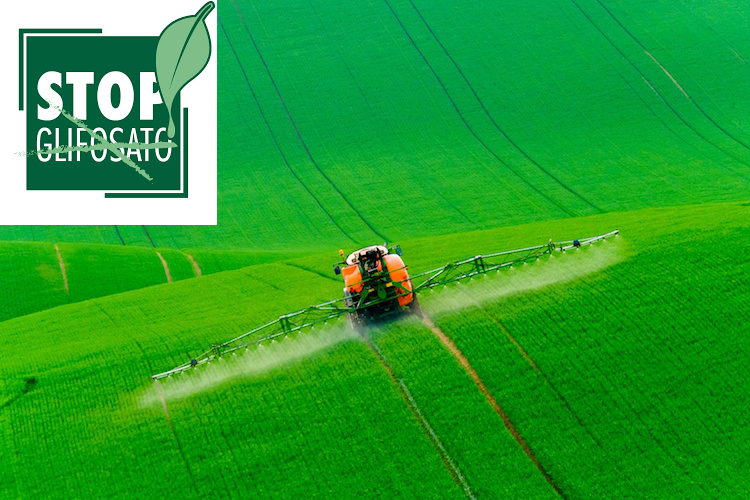Indice
Glyphosate: Impact on Health and the Environment
Introduction to Glyphosate
Glyphosate is the world’s most widely used herbicide, and the IARC classifies it as a potential carcinogen and more. Even for those not in the industry, discussing or staying informed about the effects of Glyphosate has become a daily topic. On this occasion, it’s not at all an exaggeration to be concerned about the harm this substance can cause. Let’s see what it is and how it can interfere with our diet.
Brief History and Mechanism of Action
Glyphosate is the most widespread herbicide globally, patented by Monsanto in 1974. In its action mechanism, this substance blocks essential nutrients for the plant in the soil, such as Calcium, Iron, Copper, Zinc, etc., which are vital for plants, microorganisms, and animals. When these nutrients are no longer available, the plant world (grass, trees, etc.) and various habitats linked to Chlorophyll Photosynthesis completely dry up. After 10/15 days from the treatment, the treated grass and plants appear wilted, dead!
Areas of Use and Regulation in Italy
Glyphosate is widely used for Cereals (Wheat), Vineyards, Olive Groves, Orchards, Citrus Groves, but also in industrial areas, railway sites, canal banks, ditches, private gardens, and public areas. Since August 2016, with a decree from the Ministry of Health, many products based on Glyphosate have been banned in Italy. Still, unfortunately, many others are still allowed.
Presumed Safety and Scientific Confirmations
As often happens, Glyphosate was introduced as a compound that was quickly and completely degraded without consequences for the environment and other living species, and therefore for health. This information made it the world’s most used herbicide. Sad fact! A recent article published in the New England Journal of Medicine highlighted the health risk associated with the emergence of herbaceous species resistant to the herbicide. As a result, the amounts of Glyphosate used increase significantly, and even more potent and toxic substances are added to the herbicide!
Glyphosate and Our Health
But let’s see how it interfaces with our health. Contrary to what was initially believed during its introduction and early marketing, the product is not at all harmless to health. We can come into contact both through direct exposure (for workers) and through water and food, as residues of the herbicide have been found in essential foods like bread, flours, cereals, legumes, etc., and also in meats and derived products from animals fed with contaminated feed. Glyphosate metabolites have been found in Plasma, Urine, and even Breast Milk.
Research and Data on Glyphosate
On this occasion, we’ll skip the symptoms related to acute exposure and consider the effects of accidental or unintentional ingestion through contaminated foods. The damage caused by this type of ingestion is very insidious, as it is challenging to avoid and is quite significant because, unfortunately, we are involved in chronic intakes at small doses but prolonged over time! A note: the IARC (International Agency for Research on Cancer) evaluated Glyphosate as 2A, meaning “Probable Carcinogen” (there is a scale that assigns a score related to the presence of carcinogenic activity, probable or absent), confirming an important fact: Glyphosate and the onset of Non-Hodgkin Lymphomas. The evaluations made by other (guided) agencies that tried to downplay these claims were highly controversial. But apart from the herbicide’s carcinogenic interference, there is a high correlation with other pathological realities, such as Endocrine Interference. There has been documented interference with the synthesis of Estrogens and Testosterone (important sex hormones). Very interesting are the data from research on rats fed for a long time with Corn treated with Glyphosate, which showed a high number of Tumors in most of the tested groups, but also significant Hormonal dysfunctions, in addition to damage to the Liver and Kidneys. A small curiosity: damage from Glyphosate has been shown to increase antibiotic resistance in strains of Escherichia Coli and Typhoid Salmonella.
Impact of Glyphosate on the Gut
But one aspect that closely concerns my interest in Glyphosate damage and my activities is the Alteration of Cellular Membrane Permeability at the Intestinal level (Leaky Gut Syndrome) linked to the increase in Celiac disease or significant Gluten Intolerances (Gluten Sensitivity) which are on the rise! Altered permeability subsequently alters the Intestinal Microbiota (especially Lactobacilli and Bifidobacteria). Such alteration leads to a deficit in activity, especially in Lactobacilli, resulting in the alteration of the Intestinal Bacterial Flora, promoting abnormal growth of pathogens, with predictable local and general inflammatory situations that increase Food Allergies, Gluten Intolerances, and other foods. In summary, a local reality, at the intestinal level, which is amplifying a series of disorders that include, besides the most critical situations, annoying bloating, alternating Constipation and Diarrhea forms, general suffering states including suffering in areas far from the intestine, which often tend to confuse the doctor in formulating a diagnosis. It is worth considering that the entire situation (to which I had to provide a sort of summary, for obvious reasons) also includes many realities, such as Folic Acid deficiencies, linked to the altered activity of certain bacterial strains, attacked by glyphosate, and to which the endogenous biosynthesis of Folic Acid is linked. Of great relevance are also the Antibody alterations towards Transglutaminases, enzymes responsible for the digestion of Gluten components. Chronic inflammation, which often one does not want or cannot associate with a well-defined pathological state, is also the result of the altered activity of a particular family of Enzymes, Cytochrome P450, which among many activities, also detoxifies our body from the introduction of Xeno Biotics (substances that come from the outside like toxic substances or drugs). I believe that the damages, increasingly confirmed, towards our great “friends” of the Intestinal Bacterial Flora, a very important aid for our well-being, are very important and should not be underestimated.
Conclusions and Recommendations
Let’s come to conclusions. What can we do to protect our health? Unfortunately, the action must be joint; on one side, we should identify foods and consequently farms that do not use this herbicide, and on the other, aim for a complete action towards the territory, since our health cannot improve if the territory does not improve. There are signs! Some regions in Italy are starting to ban the use of this substance. Large organized distribution groups are beginning to take a stand towards distributing untreated Wheat or banning Glyphosate from gardening products. On our part, let’s start not to underestimate certain meticulousness and turn to known products and, above all, linked to serious agricultural companies.
Article written by Dr Francesco Lampugnani


